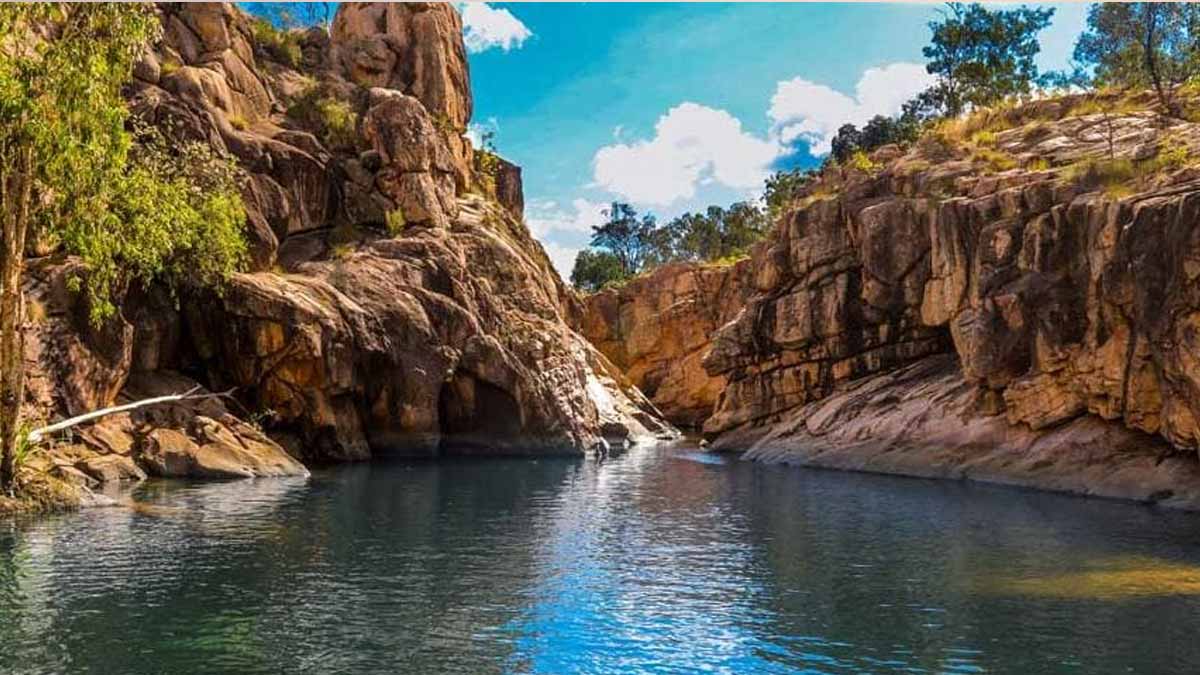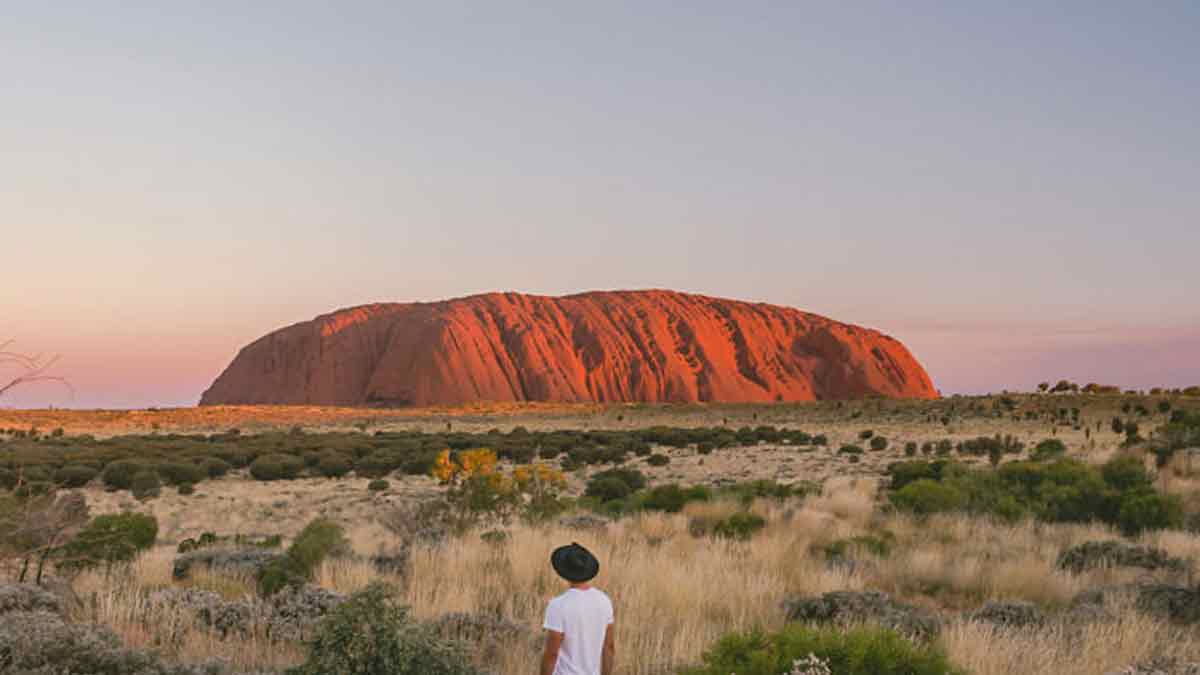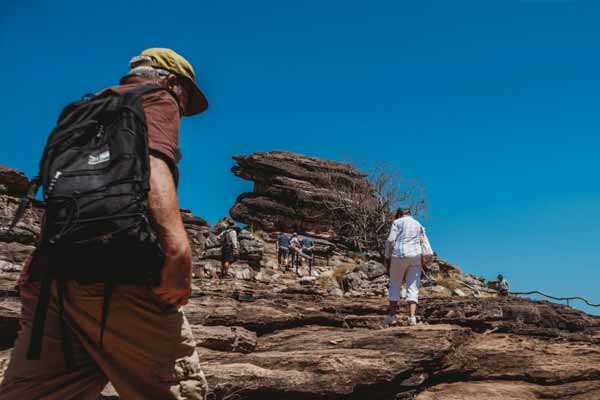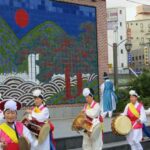Backpacking in the Northern Territory is a definite memorable experience. The Northern Territory is arguably the most beautiful and impressive part of Australia, known fondly as ‘The Outback’. The incredible landscape with its beautiful colours and vastness is what many people bring to mind when they think ‘Australia’.
Anyone backpacking in Australia needs to experience The Outback. Australia’s Northern Territory (NT) is like nowhere else on Earth. From Darwin’s famous sunsets to the ancient art and wildlife of Kakadu, the majestic Katherine Gorge through to iconic Uluru (Ayers Rock) and the outback charm of Alice Springs, there is a unique experience for every traveller waiting around the corner.
The Northern Territory is a big place where the journey between is half the adventure. Despite its size, discovering it is much easier than you might expect – with two distinct regions to explore: the Top End in the north and the Red Centre in the south. From the dryness of the central deserts to the wetlands of the north, you’ll see everything from kangaroos the size of houses to crocs the size of buses (almost!). You’ll also experience the odd lizard, beautiful birds you never thought existed and everything you’ve ever seen on the likes of Crocodile Dundee and The Crocodile Hunter.
The Northern Territory is one of the most visited Australian places on the backpacker trail. Just make sure you put enough time aside to see it properly.
Things to do in the Northern Territory
Visit the Northern Territory and you can experience fishing, cruising, hiking in the tropical wilderness and hot-air ballooning across vast deserts.
Although the Northern Territory is huge, it’s actually fairly easy to get around. The capital, Darwin, is just a short flight from all interstate capitals, as well as the nearby cities in Asia. It’s easy to get around inside the NT – you can fly from Darwin to Alice Springs and Uluru. You can also experience the legendary ‘Ghan’ – one of the most epic train journeys in the world and the best way to make your way through the Northern Territory taking in all the scenery as you go.
So indulge your senses as you explore the diversity of the Northern Territory, from the backpacker mecca of Darwin to the sacred awe-inspiring Uluru (Ayers Rock). Your time in the Northern Territory will not only be an epic adventure, it’ll also be one of your best memories of Australia…
Getting to the Northern Territory
If you’re arriving from another country, the best way to get into the NT is through Darwin’s international airport. Depending on what country you’re coming from and what airline you’re using, you may need to catch a connecting flight. For example, one of the best options for getting to the NT from the UK is to fly with Philippine Airlines, making a quick change in Manila. You can also reach the NT via Singapore.
If you’re already in Australia, you can catch domestic flights from all major cities (like Sydney, Melbourne and Perth) to Darwin. Not many people realise just how quick and easy the Northern Territory is to reach once you’re in Australia. For example, from Sydney a domestic flight takes less than five hours, and from Perth it’s less than four hours.
Alternatively, you can get in by road from the east, south and west, and rail using the Ghan train, which connects the top and bottom of Australia.
Essential Information
Equivalent in size to France, Italy and Spain combined, it’s not surprising the Northern Territory is blessed with an abundance of natural environments. The Northern Territory is often known as the ‘real Australia’. It’s where you’ll experience crocodiles, ancient rivers and locals who know the land better than you know the back of your hand.
The Aboriginal people hold a deeply spiritual connection to the land that dates back tens of thousands of years – it’s an honour to be able to share this with them today.
The Northern Territory is renowned for its colourful characters. The type you’d meet at one of their legendary outback pubs, cattle stations or country towns. Uncomplicated, larger than life, and only too willing to share a yarn or two. It’s also the perfect place to call home when you’re on your Australian working visa as it’s even easier to extend your visa if you’re staying the area.
The Northern Territory is also home to two World Heritage-listed national parks – Kakadu and Uluru-Kata Tjuta – along with over 50 other national parks, nature reserves, conservation areas and marine parks. These parks offer plenty of experiences for travellers: bushwalking, swimming under waterfalls, Aboriginal cultural tours and camping under the stars. Bushtucker trials are nothing compared to the crazy fun you’ll experience here.
Exploring Darwin
Darwin, featured in the movie Australia, is the tropical capital city of Australia’s Northern Territory. Darwin has a relaxed outdoor lifestyle and enjoys warm weather all year round. Perched on a peninsula with sea on three sides, it’s an excellent base to explore the natural attractions of World Heritage-listed Kakadu National Park, Litchfield and Nitmiluk National Parks, the Tiwi Islands and Arnhem Land.
Darwin was founded as Australia’s most northerly harbour port in 1869, and its population rapidly expanded after the discovery of gold at nearby Pine Creek in 1871. World War II put Darwin on the map as a major allied military base for troops fighting the Japanese in the Pacific.
Darwin today
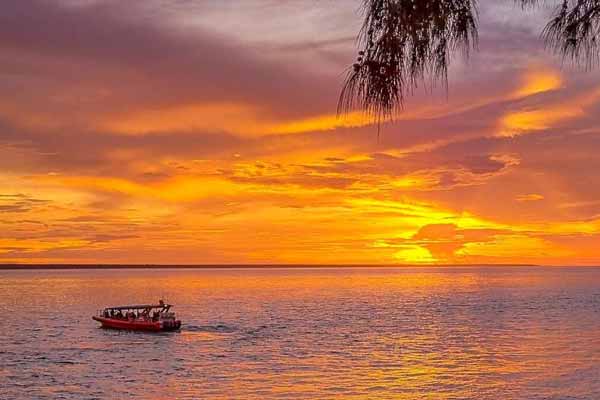
Today travellers can see evidence of Darwin’s World War II history at a variety of preserved sites including ammunition bunkers, airstrips and oil tunnels in and around the city. You can also experience the RFDS Darwin Tourist facility out on Stokes Hill Wharf, giving you an interactive experience on two of the great stories of the Northern Territory, that being the Royal Flying Doctor Service and the bombing of Darwin. Darwin again made world news when the city was rebuilt in the wake of Cyclone Tracy in 1974 – an event well documented at the Museum and Art Gallery of the Northern Territory. Its colourful history has contributed to Darwin’s cultural diversity – more than 50 nationalities make up its 100,000 population, including the area’s traditional landowners, the Larrakia Aboriginal people. The cultural and culinary benefits of such a melting pot and its close proximity to Asia are best experienced at Darwin’s weekly markets, variety of restaurants and through the annual calendar of festivals and other Darwin events.
The centre of Darwin is a great hub to relax in, with many youth hostels, hotels, cafes, restaurants, bars and nightclubs all in one space. Mitchell Street is where Darwin comes alive in the evenings.
Close to Darwin is the Mary River region. This area is renowned for its wetlands and wildlife, and is home to millions of birds, saltwater crocodiles and fish, including the mighty barramundi, which makes it a fishing hot spot. Also nearby, the Tiwi Islands’ are known for their dense rainforests, sandy beaches and rock pools. These beautiful islands lie 80 kilometres north of Darwin and can be reached by light aircraft in 20 minutes or in two and a half hours on an air conditioned boat ride.
Heritage and culture
Darwin’s cultural heritage is a unique blend of ancient Aboriginal custom, European pioneering legacy, WWII history and fresh Asian influence. A visit to the eclectic collection at the Museum and Art Gallery of the Northern Territory, just 4 kms from the city centre is a great place to start your exploration of Darwin’s heritage.
Top things to do in Darwin include: cruising the harbour (this is a good one), taking in the night life, strolling through the tropical George Brown Botanical Gardens, having a stand-off in the same tank as a crocodile at Crocosaurus Cove, browsing the open air markets at Parap, Nightcliff and Mindil Beach or catching a movie down at the Deckchair Cinema. There’s a lively atmosphere, which goes some way to explaining why it’s known as the ‘gateway to adventure’.
Exploring Kakadu and Arnhem Land
Kakadu National Park and Arnhem Land comprise more than 110,000 square kilometres or nearly 68,000 miles (basically the same size as Wales) in the north-east corner of the Northern Territory, up in what’s known as The Top End.
The landscapes are diverse and set the scene for outback adventure travel, aboriginal culture and nature activities. Nature and wildlife is abound in this area, which is known for its level of biodiversity.
Kakadu National Park is the largest national park in Australia. It contains one of the highest concentrated areas of aboriginal rock art sites in the world; the most famous examples are at Nourlangie Rock and Ubirr. While wholly aboriginal owned land, Arnhem Land is known for its strong aboriginal culture, towering escarpments, wild coastline, savannah woodlands, lush wetlands and prolific wildlife.
Famous area for backpackers
If you’re going to Australia you have to visit the Northern Territory and Kakadu National Park. It’s one of the most popular backpacker ‘Things to do’ and the biggest reason most people visit Darwin, from where the backpacker tours to Kakadu depart. Here’s one tour that is highly raved.
If you’ve seen the film Crocodile Dundee and always dreamed of seeing ‘that’ outback side of Australia, this is where it was filmed. You thought it looked great on film? You wait until you’re standing there, breathing in the air, experiencing the colours and living it for real!
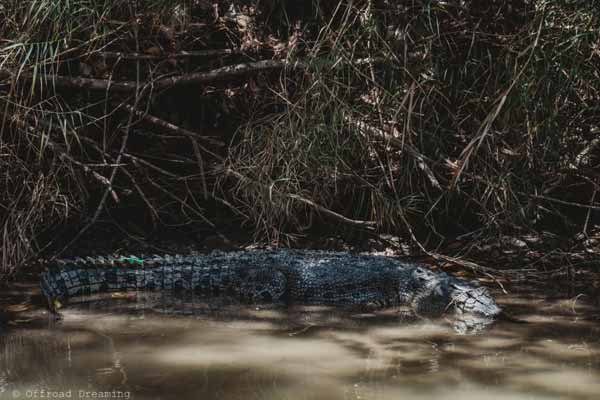
Nowhere on Earth looks, feels or sounds like the Kakadu area. Apart from seeing the odd croc the size of a bus (ok, a little exaggerated, but you might pee a little when you see your first one), you can see Aboriginal rock art, waterfalls, beaches and a landscape that hasn’t changed much for thousands of years. Suffice to say that the memories, photos and stories from Kakadu are some of the main ones from your trip that will stay with you forever.
Best time of year to go
Backpackers visit the region all the year around. Don’t let yourself be put off by the rainy / monsoon season too much if this coincides with your visit, as what this means is the odd shower of rain now and then through the day, usually for a brief period of time. In truth the heavens truly open for maybe 10-20 minutes and there is enough water to turn you into a fish, but then the sun reappears and all is well again. If you’re from the UK you’ll probably find this quite pleasant. Just pack a mac!
Best way to see Kakadu and Arnhem Land
As a backpacker there are two ways to see Kakadu, either ‘self-drive’ or with a tour. The tours that run from Darwin are the most popular because they are easy (you get picked up, fed, taken places, shown stuff and dropped off), you’re with other backpackers, they’re geared towards backpackers as opposed to older holidaymakers, most include some great deals and above all, they’re a great laugh!
If you ‘self-drive’ or sort out your own trip you generally get a more relaxed, ‘back to nature’ experience and quite often you’ll spend longer in the area as time is your own. The camping, bush walks and your ability to tune in to the Great Outdoors are limited only by your time and your imagination. Our only advice would be to team up with someone who has done a bit of this before if you are a novice, and also someone with a car helps! To find room in a car put messages up at the hostels in Darwin, although the usual safety checks on the driver and the other passengers need to apply here as you can be a little remote.
About Kakadu National Park and Arnhem Land
Kakadu National Park is one of only a handful of World Heritage sites which is listed for both its natural and cultural values. Spanning 1,980,400 hectares, the park is ecologically diverse and dynamic in landform.
A sheer and spectacular escarpment frames tidal flats, floodplains, lowlands and plateau, providing a habitat for 1600 plant species and over 200 species of birds. Kakadu is a place with no fences or boundaries, where crocodiles, snakes and other wildlife exist virtually uninterrupted by the activities of man.
Arnhem Land, which is nearby, is home to lush greens wet with colour, engulfed by white sandy beaches and wide blue skies.
Think Crocodile Dundee! While much of the classic film (staring Paul Hogan as the bushman himself) was set in America, the scenes dedicated to Australia were filmed in some of the Northern Territory’s most picturesque sites. Visitors to Kakadu National Park will feel like they’re in the movie when they visit Ubirr and Gunlom Falls.
Equally astounding are Kakadu’s caves and rock overhangs, richly decorated with Aboriginal rock art, some dating back 50,000 years, telling the stories of life of the early Aboriginal inhabitants to those still living in the park today.
From vast horizons and pristine environments to rich characters and the world’s oldest living culture, Kakadu captures the essence of Australia.
Like Australia itself, Kakadu National Park is BIG! To truly appreciate the majestic beauty and spirit of Kakadu we recommend spending around 5-6 days there.
Getting there
Getting to the Northern Territory is easy. The vibrant capital city of Darwin is closer to Asia than any other capital city in Australia and, in the centre, Alice Springs only a 2-3 hour plane ride from most Australian capital cities.
There are many flights into Darwin from Australia and overseas. You can also travel by road and rail via the Stuart Highway and the Ghan respectively.
Seasons of Kakadu
Kakadu National Park changes dramatically with the seasons and one visit just won’t be enough.
The local Bininj (indigenous) people interpret 6 different seasons. Their year starts with the scent of blossoming paperbarks, overflowing into thundering waterfalls and dazzling lightning displays, then trickling into billabongs filled with magpie geese and waterbirds.
This malleable scenery can be explored with a sweeping flight over the landscape or up close on a billabong or river cruise.
January to March: Gudjewg – Monsoon season (Wet)
April: Bang-Gerreng – Knock ’em down storm season (Wet)
May to June: Yegge – Cooler but still humid season (Dry)
June to August: Wurrgeng – Cold weather season (Dry)
August to October: Gurrung – Hot / dry weather season (Dry)
October to December: Gunumeleng – Pre-monsoon storm season (Dry / Wet)
Things to remember about Kakadu
Kakadu offers a wealth of nature and culture experiences as well as adventure experiences, such as: swimming in waterfalls and waterholes, hiking and trekking, aboriginal art and culture tours, fishing, learn about bush tucker and medicines, take a 4WD tour, learn how to play the didgeridoo, translate ancient rock art, take a boat cruise along the wetlands and marvel at the bird and wildlife or go camping.
Backpacking in Katherine
The outback meets the tropics at Katherine, about 300 kilometres south of Darwin. The township is situated on the banks of the Katherine River, which flows down from the world-renowned Katherine Gorge (Nitmiluk National Park). Sweeping from the Gulf of Carpentaria to the West Australian border, the vast Katherine region is full of hidden gems for you to explore.
Its diverse landscapes and unique ecosystems set the scene for outback adventure activities like fishing, canoeing, bushwalking, birdwatching, camping and four-wheel driving.
Day trips from Katherine can be taken north to Pine Creek or south to Mataranka Thermal Springs. Pine Creek has a strong gold mining heritage, with original buildings dating back to the 1800s, while Mataranka is famous for its tropical thermal pool and nearby Elsey National Park.
The Victoria River region, south west of Katherine, is well known as a premier fishing holiday destination. There are also excellent four-wheel drive tracks and camping spots.
Further north, the Daly River region is another spot popular for fishing and camping travellers with hot springs, gorges and rivers. The remote Gulf region, east of Katherine, is perfect for adventurous anglers who enjoy fishing in remote rivers.
Adventure in Katherine
The Katherine region sets the scene for some real Territory-style adventure. It is a relatively remote destination with abundant waterways including gorges, rivers waterfalls and the ocean. It’s these characteristics that attract an influx of adventure seekers all year round. Access is limited during the wet season.
Popular things to do in the area include: Judburra for hiking, Daly River for fishing, Nitmuluk National Park for canoeing on the Katherine River, taking a cruise or getting in touch with Aboriginal Culture at Top Didj.
Tennant Creek in Central Australia sits on the Explorer’s Way, 500 kilometres north of Alice Springs and 1000 kilometres south of Darwin. The town is surrounded to the east by the Barkly Tablelands – a huge expanse of land that supports some of Australia’s premier outback cattle stations.
History of Tennant Creek
Tennant Creek is also known as the Territory’s heart of gold; a reference to the friendliness of its people and the area’s gold mining history. Australia’s last gold rush took place here in the 1930s, and there are plenty of opportunities to learn about it at attractions around the town. Visitors can even try fossicking for their own gold.
Prior to the gold rush era, Tennant Creek’s first European residents were workers on the Overland Telegraph Line, which established a communication link between Australia and the rest of the world. The Telegraph Station was built in 1872, and this historical collection of stone buildings can be explored today. Aboriginal culture is strong in Tennant Creek.
The traditional land owners of this area are the aboriginal Warumungu people, and they recognise a number of sacred sites in the area, including the region’s most famous landmark – Karlu Karlu (The Devils Marbles) – about 100 kilometres south of the town. The Nyinkka Nyunyu Culture Centre in Tennant Creek is an award-winning aboriginal attraction that showcases the people’s stories and art. You can also do mining tours operated by the Tennant Creek Visitor Information Centre at Battery Hill.
Adventure in Tennant Creek
Adventure lovers have plenty of options in the Tennant Creek area. Four-wheel-drivers in particular are spoilt for choice with the plethora of moderate to challenging tracks available to test their skills and their vehicles.
The best things to do in Tennant Creek include: Karlu Karlu aka Devil’s Marbles, walking and hiking, Kelly’s Ranch and Barkly Tableland. Self drive touring is very popular here, and the best way to see the area.
The heart of Central Australia is comprised of cavernous gorges, boundless desert landscapes, remote Aboriginal communities and a charming pioneering history. Known as the Red Centre, this area of the Northern Territory is filled with adventure. From hiking the spectacular Larapinta Trail, camping under a million-star sky, connecting with the oldest culture on earth, or nurturing your wellbeing, the Red Centre has loads to do.
Alice Springs, or ‘The Alice’ is a small town with a big city feel. Alice Springs is the hub of the Red Centre where many tours start from to explore. Full of quirky pubs, shops, art galleries and cafes with coffee that will make you feel human again.
Alice Springs is one of the most well-known parts of the Red Centre. It was established by the early explorers and remains the centre of activity in this region. The oldest buildings in Central Australia are from the beginnings of this town, known as the Alice Springs Telegraph Station. You can still visit these buildings today. From the 1870s onwards, the vast desert of Central Australia was explored for its promise of rubies and gold. Today, north of Alice is an adventure travel destination called Gemtree where visitors can still fossick for gems and explore the Australian desert while trekking, camping or four-wheel driving.
North-west of Alice, along the Tanami Track and south of Alice Springs in the Simpson Desert, the art styles and stories of the Aboriginal people give depth and history to the surrounding landscape. The Flying Doctors, the Afghan cameleers and the legendary outback pioneers make this a fascinating stop on your Australian trip.
The most well-known natural highlights of Central Australia are the East and West MacDonnell Ranges that straddle Alice Springs and run for 223 kilometres. Visitors to the Northern Territory’s Red Centre can enjoy views of dramatic scenery, bushwalking, swimming, four-wheel driving or quad-bike riding.
The desert landscape bronzed by the sun and painted with red ochre, emerald and azure, makes this one of the most picturesque parts of Oz.
Rising from the broad desert plain in the deep centre of Australia, Uluru (aka Ayers Rock) is Australia’s most recognisable natural icon and is the spiritual heart of the continent. The famous sandstone monolith stands 348 metres high and, like an iceberg, has most of its bulk below the surface.
When you visit Uluru on your trip to Australia you can connect with the oldest living culture on earth and listen to the many local stories dating back to when time begun.
Uluru is located 440 kilometres south-west of Alice Springs in the Uluru-Kata Tjuta National Park. Just 40 kilometres to the west of Uluru / Ayers Rock is Kata Tjuta, also known as The Olgas. This massive pile of rock domes dates back 500 million years.
Both Uluru and Kata Tjuta have great aboriginal cultural significance for the Anangu traditional landowners, who lead walking tours on the local flora and fauna, bush foods and the Aboriginal Dreamtime stories of the area.
Other points of interest in Uluru
Watarrka National Park, encompassing Kings Canyon, lies 300 kilometres to the north-east of Uluru and 310 kilometres west of Alice Springs.
Kings Canyon has 300-metre-high sandstone walls, walking trails, palm-filled crevices and views across the desert.
Nature in Uluru
While the Central Australian environment may at first seem stark – a barren landscape supporting spectacular rock formations – closer inspection reveals it as a complex ecosystem, full of life.
The spinifex-covered hills, sand plains, open woodlands, limestone ridges, watercourses and swamps of Central Australia’s Northern Territory contain a variety of plants and animals that have sustained the lives of Aboriginal people for generations. An intimate knowledge of the diverse range of flora and fauna is vital to support life in the remote areas of this harsh desert landscape. This knowledge has lead people to water supplies and the understanding of the medicinal properties of plants has assisted in healing injuries and ailments for thousands of years.
Uluru walking trails Uluru is 440 kilometres south west of Alice Springs, fascinates and inspires people from around the world. Both Uluru and Kata Tjuta have great cultural significance for the Anangu traditional landowners, who lead walking tours that inform about the local flora and fauna, bush foods and the Aboriginal Dreamtime stories of the area.
The Anangu people prefer visitors don’t climb Uluru because it’s a sacred site, so nowadays many visitors choose to do the Uluru base walking trails instead.

Co-Founder of the OFT Blog. Mother of 2 who disguises as a 9 to 5 finance professional on most days. She loves to travel, is an amateur website builder and cook. And given her day job, she loves travel planning and saving money. Follow along!


